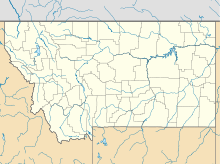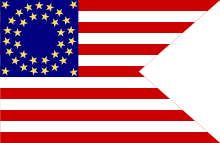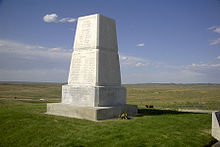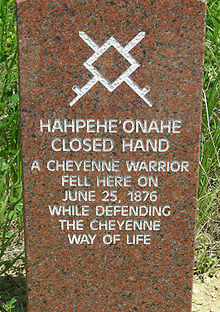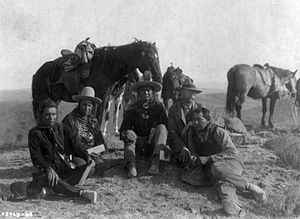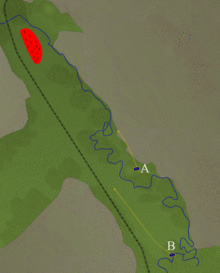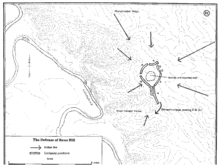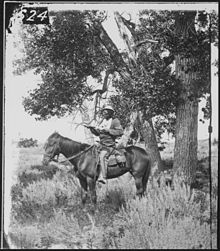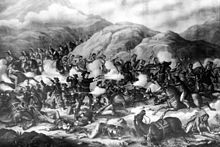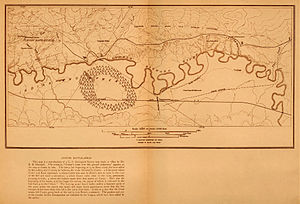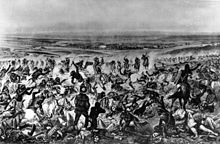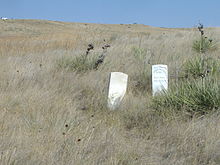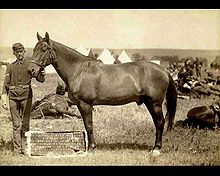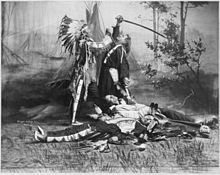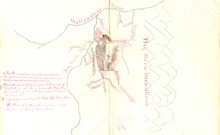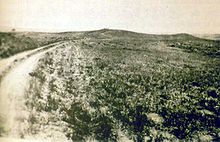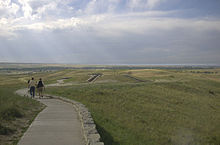
Battle of the Little Bighorn
Background to the schools Wikipedia
This selection is made for schools by a children's charity read more. See http://www.soschildren.org/sponsor-a-child to find out about child sponsorship.
| The Battle of the Little Bighorn | |||||||
|---|---|---|---|---|---|---|---|
| Part of the Great Sioux War of 1876–77 | |||||||
 "The Custer Fight" by Charles Marion Russell. |
|||||||
|
|||||||
| Belligerents | |||||||
| Lakota Cheyenne Arapaho |
|||||||
| Commanders and leaders | |||||||
| Sitting Bull Crazy Horse Chief Gall Lame White Man † |
|||||||
| Strength | |||||||
| ~900–1,800 | ~647 | ||||||
| Casualties and losses | |||||||
| 36-136 estimated killed | ~268 killed ~55 wounded |
||||||
|
|
|||||||
|
|||||
The Battle of the Little Bighorn was an armed engagement between combined forces of Lakota, Northern Cheyenne and Arapaho tribes, against the 7th Cavalry Regiment of the United States Army. The battle, which occurred on June 25 and 26, 1876 near the Little Bighorn River in eastern Montana Territory, was the most prominent action of the Great Sioux War of 1876. It was an overwhelming victory for the Lakota, Northern Cheyenne, and Arapaho, led by several major war leaders, including Crazy Horse and Chief Gall, inspired by the visions of Sitting Bull (Tȟatȟáŋka Íyotake). The U.S. Seventh Cavalry, including the Custer Battalion, a force of 700 men led by George Armstrong Custer, suffered a severe defeat. Five of the Seventh Cavalry's companies were annihilated; Custer was killed, as were two of his brothers, a nephew, and a brother-in-law. The total U.S. casualty count, including scouts, was 268 dead and 55 injured.
Public response to the Great Sioux War varied at the time. The battle, and Custer's actions in particular, have been studied extensively by historians.
Background
In 1875, Sitting Bull created the Sun Dance alliance between the Lakota and the Cheyenne and a large number of "Agency Indians" who had slipped away from their reservations joined them. During a Sun Dance around June 5, 1876 on the Rosebud River in Montana, Sitting Bull reportedly had a vision of "soldiers falling into his camp like grasshoppers from the sky." At the same time, military officials were conducting a summer campaign to force the Lakota and Cheyenne back to their reservations, using infantry and cavalry in a three-pronged approach.
Col. John Gibbon's column of six companies (A, B, E, H, I, and K) of the 7th Infantry and four companies (F, G, H, and L) of the 2nd Cavalry marched east from Fort Ellis in western Montana on March 30, to patrol the Yellowstone River. Brig. Gen. George Crook's column of ten companies (A, B, C, D, E, F, G, I, L, and M) of the 3rd Cavalry, five (A, B, D, E, and I) of the 2nd Cavalry, two companies (D and F) of the 4th Infantry, and three companies (C, G, and H) of the 9th Infantry, moved north from Fort Fetterman in the Wyoming Territory on May 29, marching toward the Powder River area. Brig. Gen. Alfred Terry's column, including twelve companies (A, B, C, D, E, F, G, H, I, K, L, and M) of the 7th Cavalry under Lieutenant Colonel George Armstrong Custer's immediate command, Companies C and G of the 17th U.S. Infantry, and the Gatling gun detachment of the 20th Infantry departed westward from Fort Abraham Lincoln in the Dakota Territory on May 17. They were accompanied by teamsters and packers with 150 wagons and a large contingent of pack mules that reinforced Custer. Companies C, D, and I of the 6th U.S. Infantry, moved along the Yellowstone River from Fort Buford on the Missouri River to set up a supply depot, and joined Terry on May 29 at the mouth of the Powder River. They were later joined there by the steamboat Far West, which was loaded with 200 tons of supplies from Fort Lincoln.
The coordination and planning began to go awry on June 17, 1876, when Crook's column was delayed after the Battle of the Rosebud. Surprised and, according to some accounts, astonished by the unusually large numbers of Native Americans in the battle, a defeated Crook was compelled to pull back, halt and regroup. Unaware of Crook's battle, Gibbon and Terry proceeded, joining forces in early June near the mouth of the Rosebud River. They reviewed Terry's plan calling for Custer's regiment to proceed south along the Rosebud, while Terry and Gibbon's united forces would move in a westerly direction toward the Bighorn and Little Bighorn rivers. As this was the likely location of Native encampments, all army elements were to converge around June 26 or 27, attempting to engulf the Native Americans. On June 22, Terry ordered the 7th Cavalry, composed of 31 officers and 566 enlisted men under Custer, to begin a reconnaissance and pursuit along the Rosebud, with the prerogative to "depart" from orders upon seeing "sufficient reason." Custer had been offered the use of Gatling guns, but declined, believing they would slow his command.
While the Terry/Gibbon column was marching toward the mouth of the Little Bighorn, on the evening of June 24, Custer's scouts arrived at an overlook known as the Crow's Nest, 14 miles (23 km) east of the Little Bighorn River. At sunrise on June 25, Custer's scouts reported they could see a massive pony herd and signs of the Native American village roughly 15 miles (24 km) in the distance. After a night's march, the tired officer sent with the scouts could see neither, and when Custer joined them, he was also unable to make the sighting. Custer's scouts also spotted the regimental cooking fires that could be seen from 10 miles (16 km) away, disclosing the regiment's position.
Custer contemplated a surprise attack against the encampment the following morning of June 26, but he then received a report informing him several hostiles had discovered the trail left by his troops. Assuming his presence had been exposed, Custer decided to attack the village without further delay. On the morning of June 25, Custer divided his 12 companies into three battalions in anticipation of the forthcoming engagement. Three companies were placed under the command of Major Marcus Reno (A, G, and M); and three were placed under the command of Capt. Frederick Benteen (H, D, and K). Five companies (C, E, F, I, and L) remained under Custer's immediate command. The 12th, Company B, under Capt. Thomas McDougall, had been assigned to escort the slower pack train carrying provisions and additional ammunition.
Unknown to Custer, the group of Native Americans seen on his trail were actually leaving the encampment on the Big Horn and did not alert the village. Custer's scouts warned him about the size of the village, with Mitch Bouyer reportedly saying, "General, I have been with these Indians for 30 years, and this is the largest village I have ever heard of." Custer's overriding concern was that the Native American group would break up and scatter. The command began its approach to the village at noon and prepared to attack in full daylight.
Prelude
7th Cavalry organization
The 7th Cavalry was created just after the American Civil War. Many men were veterans of the war, including most of the leading officers. A significant portion of the regiment had previously served four-and-a-half years at Ft. Riley, Kansas, during which time it fought one major engagement and numerous skirmishes, experiencing casualties of 36 killed and 27 wounded. Six other troopers had died of drowning and 51 from cholera epidemics.
Half of the 7th Cavalry's companies had just returned from 18 months of constabulary duty in the Deep South, having been recalled to Fort Abraham Lincoln to reassemble the regiment for the campaign. About 20 percent of the troopers had been enlisted in the prior seven months (139 of an enlisted roll of 718), were only marginally trained, and had no combat or frontier experience. A sizable number of these recruits were immigrants from Ireland, England and Germany, just as many of the veteran troopers had been before their enlistments. Archaeological evidence suggests that many of these troopers were malnourished and in poor physical condition, despite being the best-equipped and supplied regiment in the army.
Of the 45 officers and 718 troopers then assigned to the 7th Cavalry (including a second lieutenant detached from the 20th Infantry and serving in Company L), 14 officers (including the regimental commander, Col. Samuel D. Sturgis) and 152 troopers did not accompany the 7th during the campaign. The ratio of troops detached for other duty (approximately 22%) was not unusual for an expedition of this size, and part of the officer shortage was chronic, due to the Army's rigid seniority system: three of the regiment's 12 captains were permanently detached, and two had never served a day with the 7th since their appointment in July 1866. Three second lieutenant vacancies (in E, H, and L Companies) were also unfilled.
Military assumptions prior to the battle
Number of Indian warriors
As the Army moved into the field on its expedition, it was operating with incorrect assumptions as to the number of Indians it would encounter. The Army's assumptions were based on inaccurate information provided by the Indian Agents that no more than 800 hostiles were in the area. The Indian Agents based the 800 number on the number of Lakota led by Sitting Bull and other leaders off the reservation in protest of US Government policies. This was a correct estimate until several weeks before the battle, when the "reservation Indians" joined Sitting Bull's ranks for the summer buffalo hunt. However, the agents did not take into account the many thousands of "reservation Indians" who had "unofficially" left the reservation to join their "uncooperative non-reservation cousins led by Sitting Bull". The latter were those groups who had indicated that they were not going to cooperate with the US Government and live on reservation lands. Thus, Custer unknowingly faced thousands of Indians, in addition to the 800 non-reservation "hostiles". All Army plans were based on the incorrect numbers. While after the battle, Custer was severely criticized for not having accepted reinforcements and for dividing his forces, it must be understood that he had accepted the same official Government estimates of hostiles in the area which Terry and Gibbon also accepted. Historian James Donovan states that when Custer asked Gerard his estimate on the opposition, he estimated the force at between 1,500 to 2,500 warriors.
Additionally, Custer was more concerned with preventing the escape of the Lakota and Cheyenne than with fighting them. From his own observation, as reported by his trumpeter John Martin (Martini) Custer assumed the warriors had been sleeping in on the morning of the battle, to which virtually every native account attested later, giving Custer a false estimate of what he was up against. When he and his scouts first looked down on the village from Crow's Nest across the Little Bighorn River, they could only see the herd of ponies. Looking from a hill 2.5 miles (4.0 km) away after parting with Reno's command, Custer could observe only women preparing for the day, and young boys taking thousands of horses out to graze south of the village. Custer's Crow scouts told him it was the largest native village they had ever seen. When the scouts began changing back into their native dress right before the battle, Custer released them from his command. While the village was enormous in size, Custer thought there were far fewer warriors to defend the village. He assumed most of the warriors were still asleep in their teepees.
Finally, Custer may have assumed that in the event of his encountering Native Americans, his subordinate Benteen with the pack train would quickly come to his aid. Rifle volleys were a standard way of telling supporting units to come to another unit's aid. In a subsequent official 1879 Army investigation requested by Major Reno, the Reno Board of Inquiry (RCOI), Benteen and Reno's men testified that they heard distinct rifle volleys as late as 4:30 pm during the battle.
Custer had wanted to take a day and scout the village before attacking; however, when men went back after supplies dropped by the pack train, they discovered they were being back-trailed by Indians. Reports from his scouts also revealed fresh pony tracks from ridges overlooking his formation. It became apparent that the warriors in the village were either aware of or would soon be aware of his approach. Fearing that the village would break up into small bands that he would have to chase, Custer began to prepare for an immediate attack.
The role of Indian noncombatants in Custer's strategy
Lt. Colonel George A. Custer's field strategy was intended to use noncombatants at the encampments at the Battle of the Little Big Horn.
He intended to capture women, children, the elderly or disabled to serve as hostages and human shields. Custer's battalions intended to "ride into the camp and secure noncombatant hostages" and "forc[e] the warriors to surrender". Author Evan S. Connell observed that if Custer could occupy the village before widespread resistance developed, the Sioux and Cheyenne warriors "would be obliged to surrender, because if they started to fight, they would be shooting their own families."
Custer asserted in his book My Life on the Plains, published just two years before the Battle of the Little Big Horn, that:
"Indians contemplating a battle, either offensive or defensive, are always anxious to have their women and children removed from all danger…For this reason I decided to locate our [military] camp as close as convenient to [Chief Black Kettle's Cheyenne] village, knowing that the close proximity of their women and children, and their necessary exposure in case of conflict, would operate as a powerful argument in favour of peace, when the question of peace or war came to be discussed."
On Custer's decision to advance up the bluffs and descend on the village from the east, Lt. Edward Godfrey of Company K surmised:
"[Custer] expected to find the squaws and children fleeing to the bluffs on the north, for in no other way do I account for his wide detour. He must have counted upon Reno's success, and fully expected the 'scatteration' of the non-combatants with the pony herds. The probable attack upon the families and capture of the herds were in that event counted upon to strike consternation in the hearts of the warriors, and were elements for success upon which General Custer fully counted".
The Sioux and Cheyenne fighters were acutely aware of the danger posed by the military engagement of noncombatants and that "even a semblance of an attack on the women and children" would draw the warriors back to the village, according to historian John S. Gray. Such was their concern that a "feint" by Cpt. Yates' E and F Companies at the mouth of Medicine Tail Coulee (Minneconjou Ford) caused hundreds of warriors to disengage from the Reno valley fight and return to deal with the threat to the village.
Custer proceeded with a wing of his battalion (Yates' Troops E and F) north and opposite the Cheyenne circle at a crossing referred to by Fox as Ford D which provided "access to the [women and children] fugitives." Yates's force "posed an immediate threat to fugitive Indian families…" gathering at the north end of the huge encampment.
Custer persisted in his efforts to "seize women and children" even as hundreds of warriors were massing around Keogh's wing on the bluffs. Yates' wing, descending to the Little Bighorn River at Ford D, encountered "light resistance", undetected by the Indian forces ascending the bluffs east of the village.
Custer was almost within "striking distance of the refugees" before being repulsed by Indian defenders and forced back to Custer Ridge.
Captain Robert G. Carter, writing to author W.A. Graham in 1925, discussed the vulnerability of U.S. Army troops to interception and destruction by Indian defenders, outside the context of the Indian villages:
"Who knows that the same Indians [who destroyed Custer's battalion] might have done to [the column commanded by] Gibbon and Terry, had not Custer attacked …on the 25th, instead [attacking on] the 26th…and Sioux and Cheyenne forces "moving toward [Terry and Gibbon], do the very same thing [to their column] – overwhelm them by force of numbers…"
Battle participants
7th Cavalry officers at the Battle of the Little Bighorn
- Commanding Officer: Lt. Col. George Armstrong Custer (killed)
- Maj. Marcus Reno
- Adjutant: 1st Lt. William W. Cooke (killed)
- Assistant Surgeon George Edwin Lord (killed)
- Acting Assistant Surgeon James Madison DeWolf (killed)
- Acting Assistant Surgeon Henry Rinaldo Porter
- Chief of Scouts: 2nd Lt. Charles Varnum (detached from A Company, wounded)
- 2nd in command of Scouts: 2nd Lt. Luther Hare (detached from K Company)
- Pack Train commander: 1st Lt. Edward Gustave Mathey (detached from M Company)
- A Company: Capt. Myles Moylan, 1st Lt. Charles DeRudio
- B Company: Capt. Thomas McDougall, 2nd Lt. Benjamin Hodgson (killed)
- C Company: Capt. Thomas Custer (killed), 2nd Lt. Henry Moore Harrington (killed)
- D Company: Capt. Thomas Weir, 2nd Lt. Winfield Edgerly
- E Company: 1st Lt. Algernon Smith (killed), 2nd Lt. James G. Sturgis (killed)
- F Company: Capt. George Yates (killed), 2nd Lt. William Reily (killed)
- G Company: 1st Lt. Donald McIntosh (killed), 2nd Lt. George Wallace
- H Company: Capt. Frederick Benteen, 1st Lt. Francis Gibson
- I Company: Capt. Myles Keogh (killed), 1st Lt. James Porter (killed)
- K Company: 1st Lt. Edward Settle Godfrey
- L Company: 1st Lt. James Calhoun (killed), 2nd Lt. John J. Crittenden (killed)
- M Company: Capt. Thomas French
Indian leaders and warriors in the battle
- Hunkpapa (Lakota): Sitting Bull, Four Horns, Crow King, Chief Gall, Black Moon, Rain-in-the-Face, Moving Robe Women, Spotted Horn Bull, Iron Hawk, One Bull, Bull Head, Chasing Eagle
- Sihasapa (Blackfoot Lakota): Crawler, Kill Eagle
- Minneconjou (Lakota): Chief Hump, Black Moon, Red Horse, Makes Room, Looks Up, Lame Deer, Dog-with-Horn, Dog Back Bone, White Bull, Feather Earring, Flying By
- Sans Arc (Lakota): Spotted Eagle, Red Bear, Long Road, Cloud Man
- Oglala (Lakota): Crazy Horse, He Dog, Kicking Bear, Flying Hawk, Chief Long Wolf, Black Elk, White Cow Bull, Running Eagle, Black Fox II
- Brule (Lakota): Two Eagles, Hollow Horn Bear, Brave Bird
- Wahpekute (Lakota): Inkpaduta, Sounds-the-Ground-as-He-Walks, White Eagle, White Tracking Earth
- Two Kettles (Lakota): Runs-the-Enemy,
- Northern Cheyenne: Two Moons, Wooden Leg, Old Bear, Lame White Man, American Horse, Brave Wolf, Antelope Women, Big Nose, Yellow Horse, Little Shield, Horse Road, Bob Tail Horse, Yellow Hair, Bear-Walks-on-a-Ridge, Black Hawk, Buffalo Calf Road Woman, Crooked Nose, Noisy Walking
- Arapahoes: Waterman, Sage, Left Hand, Yellow Eagle, Little Bird
Notable scouts/interpreters in the battle
The 7th Cavalry was accompanied by a number of scouts and interpreters:
- Bloody Knife: Arikara/Lakota scout (killed)
- Bob Tailed Bull: Arikara scout (killed)
- Boy Chief: Arikara scout
- Charley Reynolds: scout (killed)
- Curley: Crow scout
- Curling Head: Arikara scout
- Fred Gerard: interpreter
- Goes Ahead: Crow scout
- Goose: Arikara scout (wounded in the hand by a 7th Cavalry trooper)
- Hairy Moccasin: Crow scout
- Isaiah Dorman: interpreter (killed)
- Little Brave: Arikara scout (killed)
- Little Sioux: Arikara scout
- Mitch Bouyer: scout/interpreter (killed)
- One Feather: Arikara scout
- Owl: Arikara scout
- Paints Half His Face Yellow: Crow scout
- Peter Jackson: half-Pikuni and half Blackfoot brother of William, scout
- Red Bear: Arikara scout
- Red Star: Arikara scout
- Running Wolf: Arikara scout
- Sitting Bear: Arikara scout
- Soldier: Arikara scout
- Strikes The Lodge: Arikara scout
- Strikes Two: Arikara scout
- Two Moons: Arikara/Cheyenne scout
- White Man Runs Him: Crow scout
- White Swan: Crow scout (severely wounded)
- William Jackson: half-Pikuni and half Blackfoot scout
- Young Hawk: Arikara scout
Arapaho participation
Modern-day accounts include Arapaho warriors in this fight, but the five Arapaho men were at the encampments only by accident. While on a hunting trip they came close to the village by the river and were captured and almost killed by the Lakota who believed the hunters were scouts for the US Army. Two Moon, a Northern Cheyenne leader, interceded to save their lives.
Battle engagements
Reno's attack
The first group to attack was Major Reno's second detachment (Companies A, G and M), conducted after receiving orders from Custer written out by Lt. William W. Cooke, as Custer's Crow scouts reported Sioux tribe members were alerting the village. Ordered to charge, Reno began that phase of the battle. The orders, made without accurate knowledge of the village's size, location, or the warriors' propensity to stand and fight, had been to pursue the Native Americans and "bring them to battle." Reno's force crossed the Little Bighorn at the mouth of what is today Reno Creek around 3:00 pm. They immediately realized that the Lakota and Northern Cheyenne were present "in force and not running away."
Reno advanced rapidly across the open field towards the northwest, his movements masked by the thick bramble of trees that ran along the southern banks of the Little Bighorn river. The same trees on his front right shielded his movements across the wide field over which his men rapidly rode, first with two approximately forty-man companies abreast and eventually with all three charging abreast. The trees also obscured Reno's view of the Native American village until his force had passed that bend on his right front and was suddenly within arrow shot of the village. The tepees in that area were occupied by the Hunkpapa Sioux. Neither Custer nor Reno had much idea of the length, depth and size of the encampment they were attacking, as the village was hidden by the trees. When Reno came into the open in front of the south end of the village, he sent his Arikara/Ree and Crow Indian scouts forward on his exposed left flank. Realizing the full extent of the village's width, Reno quickly suspected what he would later call "a trap" and stopped a few hundred yards short of the encampment.
He ordered his troopers to dismount and deploy in a skirmish line, according to standard army doctrine. In this formation, every fourth trooper held the horses for the troopers in firing position, with five to ten yards separating each trooper, officers to their rear and troopers with horses behind the officers. This formation reduced Reno's firepower by 25 percent. As Reno's men fired into the village and killed, by some accounts, several wives and children of the Sioux leader, Chief Gall (in Lakota, Phizí), mounted warriors began streaming out to meet the attack. With Reno's men anchored on their right by the impassable tree line and bend in the river, the Indians rode hard against the exposed left end of Reno's line. After about 20 minutes of long-distance firing, Reno had taken only one casualty, but the odds against him had risen (Reno estimated five to one) and Custer had not reinforced him. Trooper Billy Jackson reported that by then, the Indians had begun massing in the open area shielded by a small hill to the left of the Reno's line and to the right of the Indian village. From this position the Indians mounted an attack of more than 500 warriors against the left and rear of Reno's line, turning Reno's exposed left flank. They forced a hasty withdrawal into the timber along the bend in the river. Here the Indians pinned Reno and his men down and set fire to the brush to try to drive the soldiers out of their position.
After giving orders to mount, dismount and mount again, Reno told his men, "All those who wish to make their escape follow me," and led a disorderly rout across the river toward the bluffs on the other side. The retreat was immediately disrupted by Cheyenne attacks at close quarters. Later Reno reported that three officers and 29 troopers had been killed during the retreat and subsequent fording of the river, with another officer and 13–18 men missing. Most of these men were left behind in the timber, although many eventually rejoined the detachment. Reno's hasty retreat may have been precipitated by the death of Reno's Arikara Scout Bloody Knife, who had been shot in the head as he sat on his horse next to Reno, his blood and brains splattering the side of Reno's face.
Reno and Benteen on Reno Hill
Atop the bluffs, known today as Reno Hill, Reno's shaken troops were joined by Captain Benteen's column (Companies D, H and K), arriving from the south. This force had been on a lateral scouting mission when it had been summoned by Custer's messenger, Italian bugler John Martin (Giovanni Martini) with the hand-written message "Come on...big village, be quick...bring pacs" ("pacs" referring to ammunition, meaning that by this time Custer was most likely aware of the large numbers of Natives they were having to face). Benteen's coincidental arrival on the bluffs was just in time to save Reno's men from possible annihilation. Their detachments were reinforced by McDougall's Company B and the pack train. The 14 officers and 340 troopers on the bluffs organized an all-around defense and dug rifle pits using whatever implements they had among them, including knives. This practice had become standard during the last year of the American Civil War, with both Union and Confederates troops utilizing knives, eating utensils, mess plates and pans, to dig effective battlefield fortifications.
Despite hearing heavy gunfire from the north, including distinct volleys at 4:20 pm, Benteen concentrated on reinforcing Reno's badly wounded and hard-pressed detachment, rather than continuing on toward Custer. Benteen's apparent reluctance to reach Custer prompted later criticism that he had failed to follow orders. Around 5:00 pm, Capt. Thomas Weir and Company D moved out against orders to make contact with Custer. They advanced a mile, to what is today Weir Ridge or Weir Point, and could see in the distance Native warriors on horseback shooting at objects on the ground. By this time, roughly 5:25 pm, Custer's battle may have concluded. The conventional historical understanding is that what Weir witnessed was most likely warriors killing the wounded soldiers and shooting at dead bodies on the "Last Stand Hill" at the northern end of the Custer battlefield. Some contemporary historians have suggested that what Weir witnessed was a fight on what is now called Calhoun Hill. The destruction of Keogh's battalion may have begun with the collapse of L, I and C Company (half of it) following the combined assaults led by Crazy Horse, White Bull, Hump, Chief Gall and others. Other Native accounts contradict this understanding, however, and the time element remains a subject of debate. The other entrenched companies eventually followed Weir by assigned battalions, first Benteen, then Reno, and finally the pack train. Growing Native attacks around Weir Ridge forced all seven companies to return to the bluff before the pack train, with the ammunition, had moved even a quarter mile. There, they remained pinned down for another day, but the Natives were unable to breach this tightly held position.
Benteen displayed calmness and courage by exposing himself to Native fire and was hit in the heel of his boot by an Native bullet. At one point, he personally led a counterattack to push back Natives who had continued to crawl through the grass closer to the soldier's positions.
Custer's fight
The precise details of Custer's fight are largely conjectural since none of his men (the five companies under his immediate command) survived the battle. The accounts of surviving Indians are conflicting and unclear.
While the gunfire heard on the bluffs by Reno and Benteen's men was probably from Custer's fight, the soldiers on Reno Hill were unaware of what had happened to Custer until General Terry's arrival on June 27. They were reportedly stunned by the news. When the army examined the Custer battle site, soldiers could not determine fully what had transpired. Custer's force of roughly 210 men had been engaged by the Lakota and Northern Cheyenne about 3.5 miles (6 km) to the north. Evidence of organized resistance included apparent breastworks made of dead horses on Custer Hill. By this time, the Lakota and Cheyenne had already removed most of their dead from the field. The soldiers identified the 7th Cavalry's dead as best as possible and hastily buried them where they fell. By the time troops came to recover the bodies, they found most of the dead stripped of their clothing, ritually mutilated, and in an advanced state of decomposition, making identification of many impossible.
Custer was found with shots to the left chest and left temple. Either wound would have been fatal, though he appeared to have bled from only the chest wound, meaning his head wound may have been delivered post-mortem. He also suffered a wound to the arm. Some Lakota oral histories assert that Custer committed suicide to avoid capture and subsequent torture, though this is usually discounted since the wounds were inconsistent with his known right-handedness. (Other Native accounts note several soldiers committing suicide near the end of the battle.) His body was found near the top of Custer Hill, which also came to be known as "Last Stand Hill." There the United States erected a tall memorial obelisk inscribed with the names of the 7th Cavalry's casualties.
Several days after the battle, Curley, Custer's Crow scout who had left Custer near Medicine Tail Coulee, recounted the battle, reporting that Custer had attacked the village after attempting to cross the river. He was driven back, retreating toward the hill where his body was found. As the scenario seemed compatible with Custer's aggressive style of warfare and with evidence found on the ground, it was the basis of many popular accounts of the battle.
According to Pretty Shield, the wife of Goes-Ahead (another Crow scout for the 7th Cavalry), Custer was killed while crossing the river: "...and he died there, died in the water of the Little Bighorn, with Two-bodies, and the blue soldier carrying his flag". In this account, Custer was allegedly killed by a Lakota called Big-nose. However, in Chief Gall's version of events, as recounted to Lt. Edward Settle Godfrey, Custer did not attempt to ford the river and the nearest that he came to the river or village was his final position on the ridge. Chief Gall's statements were corroborated by other Indians, notably the wife of Spotted Horn Bull. Given that no bodies of men or horses were found anywhere near the ford, Godfrey himself concluded "that Custer did not go to the ford with any body of men".
Cheyenne oral tradition credits Buffalo Calf Road Woman with striking the blow that knocked Custer off his horse before he died.
Custer at Minneconjou Ford
| "Hurrah boys, we've got them! We'll finish them up and then go home to our station." |
| — Reported words of Lieutenant Colonel Custer at the battle's outset. |
Having isolated Reno's force and driven them away from the encampment, the bulk of the native warriors were free to pursue Custer. The route taken by Custer to his "Last Stand" remains a subject of debate. One possibility is that after ordering Reno to charge, Custer continued down Reno Creek to within about a half mile (800 m) of the Little Bighorn, but then turned north, and climbed up the bluffs, reaching the same spot to which Reno would soon retreat. From this point on the other side of the river, he could see Reno charging the village. Riding north along the bluffs, Custer could have descended into a drainage called Medicine Tail Coulee, which led to the river. Some historians believe that part of Custer's force descended the coulee, going west to the river and attempting unsuccessfully to cross into the village. According to some accounts, a small contingent of Indian sharpshooters opposed this crossing.
White Cow Bull claimed to have shot a leader wearing a buckskin jacket off his horse in the river. While no other Indian account supports this claim, if White Bull did shoot a buckskin-clad leader off his horse, some historians have argued that Custer may have been seriously wounded by him. Some Indian accounts claim that besides wounding one of the leaders of this advance, a soldier carrying a company guidon was also hit. Troopers had to dismount to help the wounded men back onto their horses. The fact that each of the non-mutilation wounds to Custer's body (a bullet wound below the heart and a shot to the left temple) would have been instantly fatal casts doubt on his being wounded and remounted.
Reports of an attempted fording of the river at Medicine Tail Coulee might explain Custer's purpose for Reno's attack, that is, a coordinated " hammer-and-anvil" maneuver, with Reno's holding the Indians at bay at the southern end of the camp, while Custer drove them against Reno's line from the north. Other historians have noted that if Custer did attempt to cross the river near Medicine Tail Coulee, he may have believed it was the north end of the Indian camp, although it was only the middle. Some Indian accounts, however, place the Northern Cheyenne encampment and the north end of the overall village to the left (and south) of the opposite side of the crossing. The location of the north end of the village remains in dispute, however.
Edward Curtis, the famed ethnologist and photographer of the Native American Indians, made a detailed personal study of the Battle, interviewing many of those who had fought or taken part in it. First he went over the ground covered by the troops with the three Crow scouts White Man Runs Him, Goes Ahead, and Hairy Moccasin, and then again with Two Moons and a party of Cheyenne warriors. He also visited the Lakota country and interviewed Red Hawk "whose recollection of the fight seemed to be particularly clear". Finally, he went over the battlefield once more with the three Crow scouts, but also accompanied by General Charles Woodruff "as I particularly desired that the testimony of these men might be considered by an experienced army officer". Finally, Curtis visited the country of the Arikara and interviewed the scouts of that tribe who had been with Custer's command. Based on all the information he gathered, Curtis concluded that Custer had indeed ridden down the Medicine Tail Coulee and then towards the river where he probably planned to ford it. However, "the Indians had now discovered him and were gathered closely on the opposite side". They were soon joined by a large force of Sioux who (no longer engaging Reno) rushed down the valley. This was the beginning of their attack on Custer who was forced to turn and head for the hill where he would make his famous 'last stand'. Thus, wrote Curtis, "Custer made no attack, the whole movement being a retreat".
Other views of Custer's actions at Minneconjou Ford
Other historians claim that Custer never approached the river, but rather continued north across the coulee and up the other side, where he gradually came under attack. According to this theory, by the time Custer realized he was badly outnumbered, it was too late to break back to the south where Reno and Benteen could have provided assistance. Two men from the 7th Cavalry, the young Crow scout Ashishishe (known in English as Curley) and the trooper Peter Thompson, claimed to have seen Custer engage the Indians. The accuracy of their recollections remains controversial, as accounts by battle participants and assessments by historians almost universally discredit Thompson's claim.
Archaeological evidence and reassessment of Indian testimony has led to a new interpretation of the battle. In the 1920s, battlefield investigators discovered hundreds of .45–70 shell cases along the ridge line, known today as Nye-Cartwright Ridge, between South Medicine Tail Coulee and the next drainage at North Medicine Tail (also known as Deep Coulee). Some historians believe Custer divided his detachment into two (and possibly three) companies, retaining personal command of one while presumably delegating Captain George W. Yates to command the second.
The 1920s' evidence supports the theory that at least one of the companies made a feint attack southeast from Nye-Cartwright Ridge straight down the centre of the "V" formed by the intersection at the crossing of Medicine Tail Coulee on the right and Calhoun Coulee on the left. The intent may have been to relieve pressure on Reno's detachment (according to the Crow scout Curley, possibly viewed by both Mitch Bouyer and Custer) by withdrawing the skirmish line into the timber on the edge of the Little Bighorn River. Had the US troops come straight down Medicine Tail Coulee, their approach to the Minneconjou Crossing and the northern area of the village would have been masked by the high ridges running on the northwest side of the Little Bighorn River.
That they might have come southeast, from the centre of Nye-Cartwright Ridge, seems to be supported by Northern Cheyenne accounts of seeing the approach of the distinctly white-colored horses of Company E, known as the Grey Horse Company. Its approach was seen by Indians at that end of the village. Behind them, a second company, further up on the heights, would have provided long-range cover fire. Warriors could have been drawn to the feint attack, forcing the battalion back towards the heights, up the north fork drainage, away from the troops' providing cover fire above. The covering company would have moved towards a reunion, delivering heavy volley fire and leaving the trail of expended cartridges discovered 50 years later.
Last stand
In the end, the hilltop was probably too small to accommodate the survivors and wounded. Fire from the southeast made it impossible for Custer's men to secure a defensive position all around Last Stand Hill where the soldiers put up their most dogged defense. According to native accounts, far more Native casualties occurred in the attack on Last Stand Hill than anywhere else. The extent of the soldiers' resistance indicated they had few doubts about their prospects for survival. According to Cheyenne and Sioux testimony, the command structure rapidly broke down, although smaller "last stands" were apparently made by several groups. Custer's remaining companies (E, F, and half of C,) were soon eradicated.
By almost all accounts, the Lakota annihilated Custer's force within an hour of engagement. David Humphreys Miller, who between 1935 and 1955 interviewed the last Native survivors of the battle, wrote that the Custer fight lasted less than one-half hour. Other Native accounts said the fighting lasted only "as long as it takes a hungry man to eat a meal." The Lakota asserted that Crazy Horse personally led one of the large groups of warriors who overwhelmed the cavalrymen in a surprise charge from the northeast, causing a breakdown in the command structure and panic among the troops. Many of these men threw down their weapons while Cheyenne and Sioux warriors rode them down, " counting coup" with lances, coup sticks, and quirts. Some Native accounts recalled this segment of the fight as a "buffalo run."
Custer's final resistance
Recent archaeological work at the battlefield indicates that organized resistance in the form of skirmish lines probably took place. The remainder of the battle took on the nature of a running fight. Modern archeology and historical Indian accounts indicate that Custer's force may have been divided into three groups, with the Indians' attempting to prevent them from effectively reuniting. Indian accounts describe warriors (including women) running up from the village to wave blankets in order to scare off the soldiers' horses. One 7th cavalry trooper claimed finding a number of stone mallets consisting of a round cobble weighing 8-10 pounds with a rawhide handle, which he believed had been used by the Indian women to finish off the wounded. Fighting dismounted, the soldiers' skirmish lines were overwhelmed. Army doctrine would have called for one man in four to be a horseholder behind the skirmish lines and, in extreme cases, one man in eight. Later, the troops would have bunched together in defensive positions and are alleged to have shot their remaining horses as cover. As individual troopers were wounded or killed, initial defensive positions would have been abandoned as untenable.
Under threat of attack the first American soldiers on the battlefield three days later hurriedly buried the troopers in shallow graves, more or less where they had fallen. A couple of years after the battle, markers were placed where men were believed to have fallen, so the placement of troops has been roughly construed. The troops evidently died in several groups, including on Custer Hill, around Captain Myles Keogh, and strung out towards the Little Big Horn River.
Last break-out attempt by 28 troopers
Modern documentaries suggest that there may not have been a " Last Stand", as traditionally portrayed in popular culture. Instead, archaeologists suggest that, in the end, Custer's troops were not surrounded but rather overwhelmed by a single charge. This scenario corresponds to several Indian accounts stating Crazy Horse's charge swarmed the resistance, with the surviving soldiers fleeing in panic. At this point, the fight would have become a rout with warriors riding down the fleeing troopers and hitting them with lances and coup sticks. Many of these troopers may have ended up in a deep ravine 300–400 yards away from what is known today as Custer Hill. At least 28 bodies (the most common number associated with burial witness testimony), including that of scout Mitch Bouyer, were discovered in or near that gulch, their deaths possibly the battle's final actions. Although the marker for Mitch Bouyer has been accounted for as being accurate through archaeological and forensic testing, it is some 65 yards away from Deep Ravine. Other archaeological explorations done in Deep Ravine have found no human remains associated with the battle. According to Indian accounts, about 40 men made a desperate stand around Custer on Custer Hill, delivering volley fire. The great majority of the Indian casualties were probably suffered during this closing segment of the battle, as the soldiers and Indians on Calhoun Ridge were more widely separated and traded fire at greater distances for most of their portion of the Battle than were the soldiers and Indians on Custer Hill.
Aftermath
After the Custer force was annihilated, the Lakota and Northern Cheyenne regrouped to attack Reno and Benteen. The fight continued until dark (approximately 9:00 pm) and for much of the next day, with the outcome in doubt. Reno credited Benteen's leadership with repulsing a severe attack on the portion of the perimeter held by Companies H and M. On June 26, the column under General Terry approached from the north, and the Indians drew off in the opposite direction. The Crow scout White Man Runs Him was the first to tell General Terry's officers that Custer's force had "been wiped out." Reno and Benteen's wounded troops were given what treatment was available at that time; five later died of their wounds. One of the regiment's three surgeons had been with Custer's column, while another, Dr. DeWolf, had been killed during Reno's retreat. The only remaining doctor was Assistant Surgeon Henry R. Porter.
News of the defeat arrived in the East as the U.S. was observing its centennial, and shocked people who were accustomed to battlefield victories and increasingly convinced of their inherent superiority and claim to manifest destiny. The Army began to investigate, although its effectiveness was hampered by a concern for survivors, and the reputation of the officers.
From the Indian perspective, the aftermath of the Battle of the Little Bighorn had far-reaching consequences. It was the beginning of the end of the Indian Wars, and has even been referred to as "the Indians' last stand." in the area. Within 48 hours after the battle, the large encampment on the Little Bighorn broke up into smaller groups as the resources of grass for the horses and game could not sustain a large congregation of people.
Oglala Sioux Black Elk recounted the exodus this way: "We fled all night, following the Greasy Grass. My two younger brothers and I rode in a pony-drag, and my mother put some young pups in with us. They were always trying to crawl out and I was always putting them back in, so I didn't sleep much."
The scattered Sioux and Cheyenne feasted and celebrated during July with no threat from soldiers. After their celebrations many of the Indians slipped back to the reservation, perhaps sensing that the summer of 1876 would be the last of their traditional lifeways. Soon, the number of warriors who still remained at large and hostile amounted to only about 600. Both Crook and Terry remained immobile for seven weeks after the Bighorn battle, awaiting reinforcements and unwilling to venture out against the Indians until they had at least 2,000 men. Crook and Terry finally took the field against the Indians in August. General Nelson A. Miles took command of the effort in October 1876. In May 1877, Sitting Bull escaped to Canada. Within days, Crazy Horse surrendered at Fort Robinson. The Great Sioux War ended on May 7 with Miles' defeat of a remaining band of Miniconjou Sioux.
As for the Black Hills, the Manypenny Commission structured an arrangement in which the Sioux would cede the land to United States or the government would cease to supply rations to the reservations. Threatened with starvation, the Indians ceded Paha Sapa to the United States, but the Sioux never accepted the legitimacy of the transaction. After lobbying Congress to create a forum to decide their claim, and subsequent litigation spanning 40 years, the United States Supreme Court in the 1980 decision United States v. Sioux Nation of Indians acknowledged the United States had taken the Black Hills without just compensation. The Sioux refused the money offered, and continue to insist on their right to occupy the land.
Casualties
Native American casualties
Native American casualties have never been determined and estimates vary widely, from as few as 36 dead (from Native American listings of the dead by name) to as many as 300. The Sioux chief Red Horse told Col. W. H. Wood in 1877 that the Native American suffered 136 dead and 160 wounded during the battle. In 1881, Red Horse told Dr. C. E. McChesney the same numbers but in a series of drawings done by Red Horse to illustrate the battle, Red Horse drew only sixty figures representing Lakota and Cheyenne casualties. Of those sixty figures only thirty some are portrayed with a conventional Plains Indian method of indicating death. Many historians do not agree with these categorical numbers, since Native Americans did not keep such statistics.
7th Cavalry casualties
The 7th Cavalry suffered 52 percent casualties: 16 officers and 242 troopers killed or died of wounds, 1 officer and 51 troopers wounded. Every soldier in the five companies with Custer was killed (3 Indian scouts and several troopers had left that column before the battle; an Indian scout, Curley, was the only survivor to leave after the battle had begun), although for years rumors persisted of survivors. Among the dead were Custer's brothers Boston and Thomas, his brother-in-law James Calhoun, and his nephew Henry Reed. The sole surviving animal reportedly discovered on the battlefield by General Terry's troops was Captain Keogh's horse, Comanche, although other horses were believed to have been taken by the Indians.
In 1878, the army awarded 24 Medals of Honour to participants in the fight on the bluffs for bravery, most for risking their lives to carry water from the river up the hill to the wounded. Few on the non-Indian side questioned the conduct of the enlisted men, but many questioned the tactics, strategy and conduct of the officers. Indian accounts spoke of soldiers' panic-driven flight and suicide by those unwilling to fall captive to the Indians. While such stories were gathered by Thomas Bailey Marquis in a book in the 1930s, it was not published until 1976 because of the unpopularity of such assertions. Although soldiers may have believed captives would be tortured, Indians usually killed men outright and took as captive for adoption only young women and children. Indian accounts also noted the bravery of soldiers who fought to the death.
Civilians killed
- Boston Custer: brother of George and Thomas, forager for the 7th
- Mark Kellogg: reporter
- Henry Armstrong Reed: nephew of Custer's, herder for the 7th
Legacy
Reconstitution of the 7th Cavalry – July 1876
Beginning in July, the 7th Cavalry was assigned new officers and recruiting efforts begun to fill the depleted ranks. The regiment, reorganized into eight companies, remained in the field as part of the Terry Expedition, now based on the Yellowstone River at the mouth of the Big Horn and reinforced by Gibbon's column. On August 8, 1876, after Terry was further reinforced with the 5th Infantry, the expedition moved up Rosebud Creek in pursuit of the Lakota. It met with Crook's command, similarly reinforced, and the combined force, almost 4,000 strong, followed the Lakota trail northeast toward the Little Missouri River. Persistent rain and lack of supplies forced the column to dissolve and return to its varying starting points. The 7th Cavalry returned to Fort Abraham Lincoln to reconstitute.
The expansion of the US Army
The US Congress authorized appropriations to expand the Army by 2,500 men to meet the emergency after the defeat of the 7th Cavalry. For a session, the Democratic Party-controlled House of Representatives abandoned its campaign to reduce the size of the Army. Word of Custer's fate reached the 44th United States Congress as a conference committee was attempting to reconcile opposing appropriations bills approved by the House and the Republican Senate. They approved a measure to increase the size of cavalry companies to 100 enlisted men on July 24. The committee temporarily lifted the ceiling on the size of the Army by 2,500 on August 15.
Battle controversies
Reno's conduct
The Battle Of The Little Bighorn was the subject of an 1879 U.S. Army Court of Inquiry in Chicago, held at Reno's request, during which his conduct was scrutinized. Some testimony by non-Army officers suggested that he was drunk and a coward. The court found Reno's conduct to be without fault. Since the battle, Thomas Rosser, James O'Kelly, and others continued to question the conduct of Reno due to his hastily ordered retreat. Defenders of Reno at the trial noted that, while the retreat was disorganized, Reno did not withdraw from his position until it became apparent that he was outnumbered and outflanked by the Indians. Contemporary accounts also point to the fact that Reno's scout, Bloody Knife, was shot in the head, spraying him with blood, possibly increasing his own panic and distress.
Custer's errors
General Terry and others claimed that Custer made strategic errors from the start of the campaign. For instance, he refused to use a battery of Gatling guns, and turned down General Terry's offer of an additional battalion of the 2nd Cavalry. Custer believed that the Gatling guns would impede his march up the Rosebud and hamper his mobility. His rapid march en route to the Little Big Horn averaged nearly 30 miles (48 km) a day, so his assessment appears to have been accurate. Custer planned “to live and travel like Indians; in this manner the command will be able to go wherever the Indians can,” he wrote in his Herald dispatch.
By contrast, each Gatling gun had to be hauled by four horses, and soldiers often had to drag the heavy guns by hand over obstacles. Each of the heavy, hand-cranked weapons could fire up to 350 rounds a minute, an impressive rate, but they were known to jam frequently. During the Black Hills Expedition two years earlier, a Gatling gun had turned over, rolled down a mountain, and shattered to pieces. Lieutenant William Low, commander of the artillery detachment, was said to have almost wept when he learned he had been excluded from the strike force.
Custer believed that the 7th Cavalry could handle any Indian force and that the addition of the four companies of the 2nd would not alter the outcome. When offered the 2nd Cavalry, he reportedly replied that the 7th "could handle anything." There is evidence that Custer suspected that he would be outnumbered by the Indians, although he did not know by how much. By dividing his forces, Custer could have caused the defeat of the entire column, had it not been for Benteen's and Reno's linking up to make a desperate yet successful stand on the bluff above the southern end of the camp.
The historian James Donovan believed that Custer's dividing his force into four smaller detachments (including the pack train) can be attributed to his inadequate reconnaissance; he also ignored the warnings of his Crow scouts and Charley Reynolds. By the time the battle began, Custer had already divided his forces into three battalions of differing sizes, of which he kept the largest. His men were widely scattered and unable to support each other. Wanting to prevent any escape by the combined tribes to the south, where they could disperse into different groups, Custer believed that an immediate attack on the south end of the camp was the best course of action.
Published in 1934, Frederick van de Water's biography Glory Hunter was more critical, as expressed by the title. But, it was not until the last half of the 20th century that historians fully reappraised Custer's actions, which had led to the deaths of his entire command. In this same period, activists and historians had led Americans generally to recognize their historic mistreatment of the various Indian tribes in the settling of the American West, and the role of the U.S. Cavalry in suppressing the Indians. These social changes have altered the understanding of the battle (and by extension, of Custer's role). The battle is now seen as a confrontation between Native Americans' defending their traditional lands and way of life and European-American settlers relentlessly expanding westward from their historic territory, with the aid of the US Army.
Admiration for Custer
Criticism of Custer was not universal. While investigating the battlefield, Lieutenant General Nelson A. Miles wrote in 1877, "The more I study the moves here [on the Little Big Horn], the more I have admiration for Custer." Facing major budget cutbacks, the U.S. Army wanted to avoid bad press and found ways to exculpate Custer. They blamed the defeat on the Indians' alleged possession of numerous repeating rifles and the overwhelming numerical superiority of the warriors.
The widowed Elizabeth Bacon Custer, who never remarried, wrote three popular books in which she fiercely protected her husband's reputation. She lived until 1933, thus preventing much serious research until most of the evidence was long gone. In addition, Captain Frederick Whittaker's 1876 book idealizing Custer was hugely successful. Custer as a heroic officer fighting valiantly against savage forces was an image popularized in Wild West extravaganzas hosted by showman "Buffalo Bill" Cody, Pawnee Bill, and others.
Debate over effectiveness of cavalry weapons
In defense of Custer, some historians claim that some of the Indians were armed with repeating Spencer, Winchester and Henry rifles, while the 7th Cavalry carried single-shot Springfield Model 1873 carbines, caliber .45–70. These rifles had a slower rate of fire than the repeating rifles and tended to jam when overheated. The carbines had been issued with copper cartridges. Troopers soon discovered that the copper expanded in the breech when heated upon firing; the ejector would then cut through the copper and leave the case behind, thus jamming the rifle. Troopers were forced to extract the cartridges manually with knife blades; thus, the carbines were nearly useless in combat except as clubs. During Reno's fight, Captain French was reported to have sat in the open, completely exposed to native American gunfire, extracting jammed shells from guns, reloading, and then passing them back to troopers in exchange for other jammed weapons to clear.
The Springfield Model 1873 was selected by the Army Ordnance Board after extensive testing in competition with other rifles. It was considered to be the most reliable rifle after multiple weathering tests. The choice of a single-shot rifle over repeating rifles was the Army's choice to prevent overuse of ammunition, following its emphasis at that time on marksmanship, as well as the costs of transporting cartridges along a 1,000-mile (1,600 km) supply line. Repeating rifles of the era used much lighter ammunition than the Springfields. It was not until 1876 that a heavy cartridge repeater was introduced to the market, the Winchester M1876 .45-60 rifle. However, the .45-70 cartridge was not only effective against personnel but was also large enough to bring down most horses. The carbine version used by the cavalry did not have a cleaning rod which could have been used to clear jammed cartridges. The carbine cartridges were loaded with a smaller charge of 55 grains of powder to avoid heavy recoil. While Lakota accounts noted men throwing down their rifles, in panic or possibly anger, accounts of jammed Springfield carbines were not reported in other confrontations during the Plains Wars. The jamming could have been due to the men's lack of familiarity with the Springfields, as they had been issued only weeks before the battle.
Subsequent archaeological excavations from 1983 to present have discovered evidence that cast additional light on the issue of jammed weapons. Fox notes that only 3.4% of .45/55-caliber Springfield cartridge cases from the Custer battlefield and 2.7% of cases from the Reno-Benteen field exhibit any indication they were pried from jammed weapons. These findings suggest accounts of jammed carbines were the result of misconception or a post-battle myth.
Indian accounts were documented in paintings on buffalo hides. They indicated a fight between Indian bows and arrows and cavalry pistols. While this may support the theory of carbine malfunctioning, the single-shot Springfield rifles used by the 7th had a much greater range than the Winchester and Henry rifles supposedly used by the Indians. Thus, if the troopers used skirmishers covering fixed arcs of fire, the soldiers would have been able to keep the Indians at bay for some time. Indian leaders spoke of several of their charges being repulsed, forcing the Indians to return to cover below the ridge.
As more Indians joined the fight, fire on Company L and Company C's two positions increased steadily in intensity. Indian accounts described warriors rushing army positions with bright robes to induce panic in the cavalry mounts. Another account related that soldiers (probably I Company, held initially in reserve over the crest of Finley Ridge) were rushed by warriors waving blankets and by lone warrior "bravery runs," which forced troopers to choose between holding horse reins or letting go to return fire. Soldiers aiming at oncoming Indians also had their hands pulled upwards by the frightened mounts, resulting in weapons discharged uselessly into the air. When horses carrying ammunition packs were driven off, the Indians quickly gained control of them.
While some warriors were armed with rifles (including antiquated muzzle-loaders and Army Sharps carbines which they had acquired years before in trades with settlers), the Indians also carried a large variety of traditional weapons. These included bows and arrows and several styles of heavy, stone-headed war clubs. According to Indian accounts, at least half of the Indian warriors were armed only with bows and "many arrows," making this the primary weapon. Many of the Indian participants, including the twelve year-old Black Elk, claimed to have acquired their first gun from dead troopers at the battle. The Sioux warrior White Bull described the Indians' systematically stripping slain troopers of guns and cartridge belts. As the losses mounted among Custer's men, the soldiers' fire steadily decreased, while the gunfire by the Indians, with their newly acquired weapons, increased. Cheyenne participants gave similar testimony: the Indians' firepower was increased through carbines taken from dead soldiers and ammunition recovered from the saddlebags of captured horses.
Lakota and Cheyenne bows and arrows gave a deadly advantage over the troopers on the ridge, because of its exposed terrain. Unlike the valley, the heights above the Little Bighorn River are considered completely unsuited for mounted troops. Custer's men were essentially trapped on higher ground, from which direct fire at the Indians through the high, dense brush would have been difficult. On the other hand, the Lakota and Cheyenne were able to shoot their arrows from heavy sagebrush below the ridge by aiming their arrows upward over obstacles at the puffs of smoke from the troopers' weapons. The large volume of arrows ensured severe casualties. Many of the slain troopers were found with numerous arrows protruding from their bodies. Many also had crushed skulls, likely from the Indians' stone-headed war clubs. Historians have not determined when the latter injuries occurred. Some accounts of the Indian wars describe Indian women coming onto the field after a battle and systematically bashing in the heads of the enemy dead and wounded alike.
Battlefield preservation
The site was first preserved as a United States national cemetery in 1879, to protect the graves of the 7th Cavalry troopers. In 1946 it was redesignated as the Custer Battlefield National Monument, reflecting its association with the general. In 1967, Major Marcus Reno was reinterred in the cemetery with honours, including an eleven-gun salute. In the late twentieth century, recognizing the larger history of the battle between two cultures, Congress in 1991 renamed the site the Little Bighorn Battlefield National Monument.
United States memorialization on the battlefield began in 1879 with a temporary monument to U.S. dead. In 1881 the current marble obelisk was erected in their honour. In 1890 marble blocks were added to mark the places where the U.S. cavalry soldiers fell.
Nearly 100 years later, ideas about the meaning of the battle have become more inclusive. The United States government acknowledged that Native American sacrifices also deserved recognition at the site. The 1991 bill changing the name of the national monument also authorized an Indian Memorial to be built near Last Stand Hill in honour of Lakota and Cheyenne warriors. The commissioned work by Native artist Colleen Cutschall is shown in the photograph at right. On Memorial Day 1999, in consultation with tribal representatives, the US added two red granite markers to the battlefield to note where Native American warriors fell. As of December 2006, a total of ten warrior markers have been added (three at the Reno-Benteen Defense Site, seven on the Little Bighorn Battlefield).
Battle of the Little Bighorn in popular culture
In paintings
- In 1896, Anheuser-Busch commissioned from Otto Becker a lithographed, modified version of Cassily Adam's painting "Custer's Last Fight", which was distributed as a print to saloons all over America. It is reputed to still be in some bars today.
- Edgar Samuel Paxson completed his painting "Custer's Last Stand" in 1899. In 1963 Harold McCracken, the noted historian and Western art authority, deemed Paxson's painting "the best pictoral representation of the battle" and "from a purely artistic standpoint...one of the best if not the finest pictures which have been created to immortalize that dramatic event."
- Noted artist Charles Marion Russell painted "The Custer Fight" in 1903, concentrating on the Indians.
- In 1996 Allan Mardon completed one of his most significant works, "The Battle of Greasy Grass," which remains in the permanent collection of the Buffalo Bill Historical Centre in the Whitney Gallery of Western Art in Cody, Wyoming.
In film, television and on radio
- In 1912, the first movie about the battle titled Custer's Last Fight was released.
- The 1936 film serial Custer's Last Stand is a heavily fictionalized version of events leading up to the battle.
- They Died with Their Boots On (1941) was a highly fictionalized account of the battle with Custer portrayed by Errol Flynn.
- In the 1954 western Sitting Bull, Chief Sitting Bull of the Sioux tribe is forced by the Indian-hating General Custer to react with violence, resulting in the famous Last Stand at Little Bighorn.
- On November 21, 1953, the radio series Gunsmoke broadcasted an episode called "Custer" that featured a young murderer getting away with his crime, only to be fatefully stationed with Custer and the 7th Calvary on their way to the Little Bighorn. It was rebroadcast on September 22, 1957 and also adapted for the television episode that aired on September 22, 1956.
- In 1956 movie, 7th Cavalry, directed by Joseph H. Lewis, the captain Benson ( Randolph Scott), aide-de-camp of colonel Custer, comes back to the fort just after the battle and discovers half of the men died. Because he was on leave during the battle, he's seen as a coward by the other soldiers.
- The 1958 Walt Disney Studios film Tonka is a highly fictionalized history of the horse Comanche that survived the battle. This was the first film to tell the story from the Indian point of view, with a fairly accurate version of the battle taking place near the end of the film.
- The "Comanche" episode of Have Gun-Will Travel airing May 16, 1959 has Paladin hearing the gunfire in the distance, and arriving at the Little Big Horn shortly after the battle.
- In a 1963 episode of The Twilight Zone titled " The 7th Is Made Up of Phantoms", three members of a modern National Guard troop suddenly join the battle on the side of Custer but are unable to use their M5 Stuart tank.
- The 1965 film The Great Sioux Massacre stars Philip Carey as Custer and Darren McGavin as Captain Benteen (called Benton in this film).
- A 1967 television series Custer, starring Wayne Maunder in the title role, lasted 17 episodes before cancellation.
- The 1967 film Custer of the West stars Robert Shaw as Custer and concludes with the Little Big Horn battle.
- The 1970 film Little Big Man portrays a manic and somewhat psychotic Custer ( Richard Mulligan) realizing to his horror that he and his command are "being wiped out." (Mulligan later reprised his "crazy Custer" character in the 1984 film Teachers).
- The 1977 television film The Court-Martial of George Armstrong Custer, starring James Olson as Custer, was based on a controversial best-selling novel by Douglas C. Jones in which Custer survives the battle and must explain his actions in court.
- The television miniseries Son of the Morning Star, based on Evan S. Connell's bestselling book, debuted in 1991. The film recounted the story of Custer ( Gary Cole) and the Battle of the Little Big Horn.
- The History Bites episode "The Truth Is Out There" explored the battle via a parody of The X Files, among other things.
- The 2005 TV miniseries Into the West included a version of the battle.
- In 2007 the BBC presented a one hour drama-documentary titled Custer's Last Stand.
- In 2011 the BBC broadcast a radio programme in which Melvyn Bragg (and guests) discussed the battle.
In fiction
- The 1956 novel The Dice of God written by Hoffman Birney features a fictionalized account of the battle. It was filmed by Levy-Gardner-Laven in 1965 as The Glory Guys.
- The protagonist of Thomas Berger's 1964 novel Little Big Man describes himself as the sole white survivor of the Battle of the Little Bighorn; while not the focus of the book, the battle serves as the climactic episode of the narrative.
- George MacDonald Fraser placed his fictional anti-hero Flashman at the battle in his book Flashman and the Redskins.
- Frederick J. Chiaventone wrote A Road We Do Not Know: A Novel of Custer at the Little Bighorn in 1996.
- Marching to Valhalla: A Novel of Custer's Last Days was written by Michael Blake, who also wrote Dances with Wolves.
- Fictional character Morgan Kane fought under Custer in the book Where the Eagles die, one of the 83 books in the Morgan Kane book series.
In music
- In 1960, country singer Johnny Horton released the album Johnny Horton Makes History featuring the song "Comanche (The Brave Horse)" about the only animal from the American forces to survive the Battle of Little Big Horn. That same year Larry Verne released a comedy hit song titled "Please, Mr. Custer (I don't wanna to go)" about a fictitious cavalryman who asked Custer not to join the battle after a nightmare he experienced the night before. This song was later re-recorded by Marty Robbins.
- The Blazon Stone album by German power metal band Running Wild includes a song depicting the battle titled "Little Big Horn".
- The Return Of The Pride album by rock band White Lion includes a song depicting the battle titled "Battle at Little Big Horn".
- In 1989, British keyboard player Rick Wakeman composed the song "Custer´s Last Stand", released on his 1988 album The Time Machine.
- The title track from The Minutemen album The Punch Line (1981) documents the battle in a facetious manner.
- The song "Glory Hunter" by Heavy Metal band Armored Saint from their 1984 album March of the Saint.
- The song "Battle of Little Bighorn" by Christian artist and Native American Redcloud from his album Hawthorne's Most Wanted.
- The song "Trip to Little Big Horn" by country artist Marty Stuart from his 2005 album Badlands: Ballads of the Lakota.
In video games
- The video game Darkest of Days has the player participate in the battle as a soldier under Custer's command.
- The battle appears as the final level in the campaign of the computer game Age of Empires III: The War Chiefs where the player must kill Custer and his troops as part of the Indian army.
- Custer's Revenge
